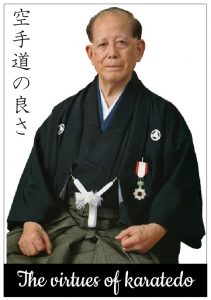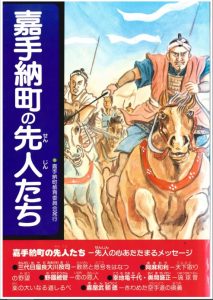
Without succumbing to many pressures, the karatedō left by our Okinawan ancestors has been cultivated over a thousand years and has discovered the truth of "Karate ni sente nashi " – There is no first attack in karate". I am convinced that real world peace will be achieved if the veracity of "Karate ni sente nashi” is demonstrated without changing both now and in the future.
The virtues of karatedō:
- Karate can be practiced alone, but can also be practiced by many people together.
- Karate can be practiced freely by anyone that is to say children, seniors, men and women alike.
- Karate training can be either vigorous or light depending on one’s physical strength.
- Karate training can be done even in a narrow space.
- Karate gives courage to those who lack it and willpower to those who lack it.
- Karate promotes health and doubles work efficiency.
- Karate makes life brighter ensuring longevity and peace.
What country in the world possesses such an ideal cultural property? It is a wonder that in such a small island nation, through a long history, karate has survived to the present day according to the words of the ancestors "truth withstands winds".
December 10, 1967
The 1st Karatedō Kobujutsu Demonstration
Sponsored by the All Okinawa Karatedō Federation
NAGAMINE Shōshin, Chairman of the All Okinawa Karatedō Federation
Extracts from the Chairman's Greeting
A few months ago, a few Shōrin-ryū masters from mainland Japan visited Maeshiro Morinobu sensei in his Shidōkan Musei Juku dōjō for instruction. Recently, Maeshiro sensei has been recognized as a cultural asset holder for Okinawa karate by the Okinawa Prefecture.
Later on, the visiting masters posted some bunkai video on Youtube. Since they are titled in Japanese, overseas karateka may not have the chance to look at these very instructive videos.
We are listing them below together with the said kata performed by Matsujō Tadashi sensei, who also belongs to the Okinawa Shōrin-ryū Karatedō Kyōkai (association).
Please be aware that training should be held under the supervision of a qualified instructor. Our center cannot be held responsible for any injury that may occur through the practice of the contents of these videos.
Passai Dai or Matsumura no Passai – Kata:
https://okinawa-karate.okinawa/kata-movie/naha-shuritekei-passai-dai/
Matsumura no Passai (kata) Bunkai No. 1
https://www.youtube.com/watch?v=6jDn13V_M-A&t=6s
Matsumura no Passai (kata) Bunkai No. 2
https://www.youtube.com/watch?v=wmxuEKMCiPQ
Matsumura no Passai (kata) Bunkai No. 3
https://www.youtube.com/watch?v=bUA5nFxb2ME
Matsumura no Passai (Kata) Bunka No. 4
https://www.youtube.com/watch?v=E7bdDh5mt6g
Matsumura no Passai (kata) Bunkai No. 5
https://www.youtube.com/watch?v=RQEFHlrqoO0
Matsumura no Passai (kata) Bunkai No. 6
https://www.youtube.com/watch?v=20z7DL5JuJ4
Matsumura no Passai (kata) Bunkai No. 7
https://www.youtube.com/watch?v=UJO60BDLyNQ
Matsumura no Passai (kata) Bunkai No. 8
https://www.youtube.com/watch?v=YIyH7Xt2kWA
Okinawa Kōkai no Yūbe
National special invitation exemplary demonstration (Part III)
(Published on September 23, 1969)
Striving to spread karate
Yagi Meitoku Hanshi (Gōjū-ryū Meibukan)
Sūpārinpe
When Mr. Yagi was told that he had passed entrance to middle school (Nicchu) (1), he was immediately taken by his grandfather to become a student of Gōjū-ryū Miyagi Chōjun sensei. His grandfather had studied kanji and karate in the province of Fujian, China. Since he was a descendant of Jana Uēkata who was well versed in the pen and the sword, his grandfather believed that martial arts were compulsory and Mr. Yagi was forced to learn karate.
Mr. Yagi received tuition from the age of 14 years old until after the war, when Miyagi was still alive. Miyagi sensei was a very strict person, and rather than teaching karate at the beginning, he had people sit and listen to him for one to two hours. As this was both mentally and physically difficult, it is said that not many students stayed for a long time. However, it was the master’s principle to teach only the ones who would keep up with him.
Since being in fourth grade at Nicchu, Yagi Hanshi instructed students at a club in Kume district, and after the war he has worked on popularizing karate teaching at the Budō hall of the Customs office. Currently, he has built the Meibukan in his home in Kume district and is working on nurturing the successors of Gōjū-ryū.
Yagi Hanshi will demonstrate Sūpārinpe that he learned from Miyagi sensei. In kanji, this kata’s name is written “One hundred eight hands” and is also called hyaku hachi no te (108 hands). By the way, the watch-night bell also rings 108 times. As Goju-ryu's Sūpārinpe is the last kata to be taught, it is a kata learned by 5th dan and higher people. It is a long and very sober kata which doesn’t have the flashiness of Kūsankū or Passai.
Yagi Hanshi said, “I have shown this kata to mainland Japan’s Gōjū-ryū dōjō as I had filmed it with an 8 millimeter camera, but with the coming special demonstration at the Nippon Budōkan, I wish to perform in front of many karate people and it would be great if it could serve as a reference for Gōjū-ryū.”
Vice Chairman of All Okinawa Karatedō Federation, Gōjū-kai Chairman, from Kume district, Naha City, 57 years old.
Notes:
(1) Nicchu was the 2nd middle school of the Okinawa Prefecture, while Icchu was the 1st middle school. They are respectively today’s Naha Senior High School and Shuri Senior High School.
Some folktales of Yomitan village have been released online. Among them are stories relating to karate master Kyan Chōtoku also known as Chan-mīgwā.
Below we offer a non official translation of the narration.
Title: Chan-mīgwā (Iramina District)
Based on the folktales by Matsuda Nobumasa (born in 1896)
(First folktale)
Chan-mīgwā weighted approximately 50kg, was skinny and at first sight he didn’t look strongly built.
However, he excelled in martial arts and was a very powerful man.
Before the war, when he performed karate at Harayama Shobu (1) in front of the Yomitan village office, his arms and entire body were muscle-tightened like steel.
Everyone was extremely surprised by this superb expert.
Chan-mīgwā was a horse carriage owner by Hīja Bridge.
Once as he went charging rice bags on a horse carriage, carriers from Yonabaru were also present.
As Chan-mīgwā was charging his rice bags slowly as always, the rough Yonabaru carriers got mad and told Chan-mīgwā to “get out of the way. We are going first” and try to start charging their rice bags first.
At that sight, Chan-mīgwā got mad. “What are you saying?! There is an order in things. Don’t behave selfishly!”
So saying, he start kicking the rice bags to put them on the carriage and filled the carriage in no time.
Watching the scene, the Yonabaru carriers realized that they were facing a man with extraordinary power and fluttered by the amazing skills of Chan-mīgwā run away frightened as they were.
(1) Agriculture encouragement contests
(Second folktale starting at 1:49)
And another story…
Chan-mīgwā was teaching karate to the daughter of Yara Rindō
And eventually they felt in love.
One day, as Chan-mīgwā was going as always to the house of the daughter
Some men came pretending that he was trying to take away the Yara daughter and that this behavior couldn’t be accepted.
The young men of Yara came with sticks and altogether chased Chan-mīgwā.
Seeing this, as he was in the vicinity of Hīja Bridge, Chan-mīgwā caught the daughter on his waist and jump on the bridge parapet. The young men did their best to chase him but were incapable of doing so and Chan-mīgwā run away.
Later he and the Yara Rindō daughter became husband and wife.
As you can see, not only being a splendid martial expert, he was a light-footed although being a small person. One day, he escaped by jumping from one roof to the other. It is said that this scene looked like it was a bird flying.
The end!
(The two other folktales are not karate related so forgive us for not translating the narration.)
Extra note:
A similar episode is also introduced in the book "Kadena Town's pioneers" published in 1993 by the Kadena Town Board of Education.
In the 18-page chapter dedicated to Okinawa karate and Kyan Chōtoku is written the following.
“Chōtoku who had a house closed by Hīja Bridge decided to start a business of carrying goods from the port to the Naha port’s warehouse (Tundō). As goods were carried by horse carriage, carriers were called “Basha-muchā” or horse coach owner. The work of a carriage owner was a very heavy labor. Therefore, most of the owners were rough people, and most of them were big men hard to be dealt with. Among them, owners care less of each other. On the way to Naha, while the roads were tight, carriers would not give priority to others and this would often lead to people fighting each other. When arriving at the warehouse, they would fight for the order of delivering their freight. These rough men were confident in their dexterity.”
After this explication, the same episode with the big men from Yonabaru is introduced. However, it is said that Kyan Chōtoku charged sugar bags rather than rice bags doing so not with his feet but using a rokushakubō staff.
Okinawa Kōkai no Yūbe
National special invitation exemplary demonstration (Part III)
(Published on September 23, 1969)
Performig with pride
Higa Yūchoku Hanshi (Shōrin-ryū Kyūdōkan)
Passai Dai
Although Higa Hanshi is a robust type of man, when young he was stooped and weak. Then, at the age of seventeen, he was introduced to his father's friend Mr. Shiroma Jirō and started karate to develop physical strength. After receiving tuition from Mr. Shiroma for five years, he also received guidance from Shinzato Jin-an sensei of Gōjū-ryū and Miyahira Seiei sensei.
After the war, having had his kata Passai Dai and Naihanchi Sandan checked by Chibana Chōshin sensei, he became a student at Chibana sensei’s. While Higa Hanshi received guidance of Gōjū-ryū before the war and Shōrin-ryū after the war, even today his use of the waist and his way of stepping among others are filled with Gōjū-ryū’s blood. The Passai Dai that Higa Hanshi will perform is Chibana sensei’s specialty. Higa Hanshi is also eager to proudly perform at this performance.
It is said that this Passai Dai was created by Matsumura Sōkon sensei, who served as an instructor during the Ryūkyūan dynasty. It is a representative kata of “Shurite”. It is said that at his time King Shō Kō (Buddhist Lord) (1) also exerted himself in the training of Passai Dai.
Higa Hanshi has been working hard on researching karatedō for more than 40 years, and today, as the chairman of the board of the All Okinawa Karatedō Federation (2), he is also putting a lot of effort into nurturing the karate of the cradle. Higa Hanshi said, “Okinawa’s karatedō is in the spotlight of the world. However honestly, there are many worries about karatedō like the differences in styles and various complicated problems. Particularly, competitive karate, which is contrary to Okinawa's view on karate, is popular in mainland Japan. While we need to establish a firm direction for the future of karatedō, we also need to exert ourselves in strengthening our federation’s organization and strive for the sound development of karatedō.” Born in Wakasa district, Naha City, 59 years old.
Notes:
(1) On the monument in the graveyard of the Matsumura family is written “He served as a guard of the royal government for three generations, including the 17th King Shō Kō, the 18th King Shō Iku and the 19th King Shō Tai of the second Shō Dynasty. Although the character is different, it is probably King Shō Kō who served as king from 1804 to 1834.
(2) In Japanese, Rijichō of the Zen Okinawa Karatedō Renmei


